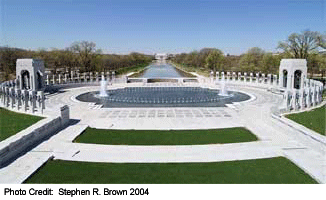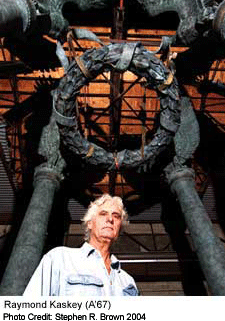
When the eyes of the nation focused on Washington, D.C., Memorial Day weekend, they took in the splendor and magnificence of the seven-acre National World War II Memorial on the National Mall. But, what they didn't see were the artists behind this impressive tribute to American WWII veterans, Friedrich St. Florian and Carnegie Mellon alumnus Raymond Kaskey (A’67).
St. Florian is the architect who created the “big picture”—the initial design that beat nearly 400 others in a national competition sponsored by the American Battle Monuments Commission. But it’s Kaskey, the memorial’s “principal artist,” who shines through in all the details, even the design of the flagpole, which Kaskey says, was inspired by the cupola on Carnegie Mellon’s Hamerschlag Hall.
The National World War II Memorial sits between the Lincoln Memorial and Washington Monument. Two arches, one on each end of the memorial, symbolize the Atlantic and Pacific war fronts, while 56 pillars surrounding them represent the U.S. states, territories and the District of Columbia. The Freedom Wall features 4,000 bronze stars, each representing 100 American war casualties. The Circle of Remembrance offers a garden and benches that give visitors an opportunity to pause and reflect.

Kaskey designed and created the detailed sculptures of four bronze eagles holding a laurel wreath aloft in both the Atlantic and Pacific arches, and the wreathes that adorn the memorial's 56 pillars. Kaskey and his team of three sculptors designed and sculpted the bronze stars on the memorial's Wall of Valor, making the wall look like a work of art—rather than just a field of stars. Kaskey and his team also designed and constructed 24 bas-reliefs, 12 panels representing the war on the Atlantic front and 12 for the Pacific. Some panels depict the war itself, while others demonstrate the way the war impacted life on the homefront.
The journey from idea to reality took seven years of hard work and dedication. Kaskey collaborated with St. Florian through each step of the monument's design, creating small models of each sculpture that went through numerous iterations. The models then were presented at several private and public hearings. Kaskey and St. Florian incorporated suggestions into new models, which were then used to create the sculptures.
The memorial opened to the public in April and Kaskey's final sculptures were installed in May—just in time for the Memorial Day dedication ceremony. Even with the amount of work and materials involved, the project was still completed one year ahead of schedule and millions of dollars under-budget.
Now that the memorial is finished Kaskey says that he feels relieved, "but empty too. It's almost like post-partum depression."
"It was a little overwhelming," he added, "but it's a great honor. The biggest job I'll ever do. Definitely the high point of my career."
Kaskey says he's only worked on one other project that approaches the scope and magnitude of the National World War II Memorial: "Portlandia," a sculpture in Portland, Oregon. Often called the Statue of Liberty of the West, Portlandia is made from hammered-copper, just like the original Lady Liberty. She was Kaskey's first major project and bears the face of his wife, Sherry Kaskey (MM'67), who is also an artist.
"We met at Carnegie Tech," Kaskey said. "It's one of my greatest memories."
Kaskey also recalls working with Carnegie Tech architecture professor Kent Bloomer, who still inspires him. "He influenced me incredibly to go into sculpture," he said. Kaskey worked as Bloomer's studio assistant and helped him work on the bas-relief on the addition of Rodef Shalom Synagogue in Squirrel Hill. "We really took him seriously," said Kaskey. "He was my biggest influence at Carnegie Tech."



